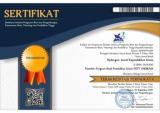Synthesis of Silicon/Silica/Carbon Composite from Rice Husk via Mechanical Milling Method as Anode Lithium-Ion Batteries
Abstract
Keywords
Full Text:
PDFReferences
Al Ja’farawy, M. S., Hikmah, D. N., Riyadi, U., Purwanto, A., & Widiyandari, H. (2021). A Review: The Development of SiO2/C Anode Materials for Lithium-Ion Batteries. Journal of Electronic Materials, 50(12), 6667–6687. https://doi.org/10.1007/s11664-021-09187-x
Hamedani, A. A. (2021). Development of Silicon/Carbon Nanocomposite Anodes From Simple Precursors for Lithium-Ion Batteries. Sabanci University.
Hou, J., Mao, X., Wang, J., Liang, C., & Liang, J. (2021). Preparation of rice husk-derived porous hard carbon: A self-template method for biomass anode material used for high-performance lithium-ion battery. Chemical Physics, 551(June), 111352. https://doi.org/10.1016/j.chemphys.2021.111352
Huang, X., Cen, D., Wei, R., Fan, H., & Bao, Z. (2019). Synthesis of Porous Si/C Composite Nanosheets from Vermiculite with a Hierarchical Structure as a High-Performance Anode for Lithium-Ion Battery. ACS Applied Materials and Interfaces, 11(30), 26854–26862. https://doi.org/10.1021/acsami.9b06976
Kim, M., Yang, Z., & Bloom, I. (n.d.). The lithiation/delithiation behavior of Si-based electrodes: A connection between electrochemistry and mechanics. Journal of The Electrochemical Society.
Majeed, M. K., Saleem, A., Wang, C., Song, C., & Yang, J. (2020). Simplified Synthesis of Biomass-Derived Si/C Composites as Stable Anode Materials for Lithium-Ion Batteries. Chemistry - A European Journal, 26(46), 10544–10549. https://doi.org/10.1002/chem.202000953
Shen, T., Xie, D., Tang, W., Wang, D., Zhang, X., Xia, X., Wang, X., & Tu, J. (2017). Biomass-derived carbon/silicon three-dimensional hierarchical nanostructure as anode material for lithium ion batteries. Materials Research Bulletin, 96, 340–346. https://doi.org/10.1016/j.materresbull.2017.04.014
Tian, H., Tan, X., Xin, F., Wang, C., & Han, W. (2015). Micro-sized nano-porous Si/C anodes for lithium ion batteries. Nano Energy, 11, 490–499. https://doi.org/10.1016/j.nanoen.2014.11.031
Wang, L., Gao, B., Peng, C., Peng, X., Fu, J., Chu, P. K., & Huo, K. (2015). Bamboo Leaves Derived Ultrafine Si Nanoparticles and Si/C Nanocomposites. Nanoscale. https://doi.org/10.1039/x0xx00000x
Wang, Z., Zheng, B., Liu, H., Zhang, C., Wu, F., Luo, H., & Yu, P. (2021). One-step synthesis of nanoporous silicon @ graphitized carbon composite and its superior lithium storage properties. Journal of Alloys and Compounds, 861(xxxx), 157955. https://doi.org/10.1016/j.jallcom.2020.157955
Zheng, C. H., Zhang, G. P., Wang, S. S., Mao, A. Q., & Fang, D. L. (2021). Efficient transformation of rice husk to a high-performance Si@SiO2@C anode material by a mechanical milling and molten salt coactivated magnesiothermic reduction. Journal of Alloys and Compounds, 875, 159974. https://doi.org/10.1016/j.jallcom.2021.159974
DOI: https://doi.org/10.33394/hjkk.v13i3.16618
Refbacks
- There are currently no refbacks.

This work is licensed under a Creative Commons Attribution-ShareAlike 4.0 International License.





